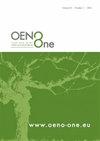葡萄(Vitis vinifera)树龄和冬季修剪特征对木质部水分运输的影响
IF 2.2
3区 农林科学
Q3 FOOD SCIENCE & TECHNOLOGY
引用次数: 0
摘要
为了研究树龄和修剪特征对葡萄水分传导的影响,在2017年至2020年间进行了一项研究。在法国东北部汝拉地区和波尔多西南部的两个不同葡萄园地块上,考虑并比较了两种修剪制度(尊重或不尊重树液流动路径)和两种葡萄树龄水平(较老和较年轻的葡萄植株)。与树液流动路径相关的修剪特征评估是基于树干和手臂外部木材外观的视觉特征,并包括一组涉及修剪伤口数量、大小和位置的标准。使用Xyl’em®工具对整个藤蔓植物的汁液流量进行了测量,并在Phloxine染色后对树干和枝条中坏死、存活和导电的木质部区域进行了评估。还对植被的生物量进行了评估。结果表明,在不考虑树液流动路径的情况下修剪的葡萄藤的传导性树液流动比考虑树液路径的葡萄藤少40-50%。在每个修剪制度下,没有观察到葡萄藤年龄的差异。然而,对于评估传导木质部面积的葡萄园地块,未按照树液路径修剪的较老葡萄藤显示出比按照树液流动修剪的较旧葡萄藤更小的活木和传导木面积。这些葡萄藤的生活区和传导区的数量相当于为尊重树液路径而修剪的年轻葡萄藤的面积。这些较老的葡萄藤也显示出较少的营养生物量。这些结果表明,在不考虑树液通道的情况下进行修剪,无论是从水力效率还是活组织和传导组织的数量来看,都会对葡萄木质部树液通道传导产生负面影响。然而,这些减少对葡萄生理功能的可能影响仍有待进一步研究。本文章由计算机程序翻译,如有差异,请以英文原文为准。
Xylem water transport is influenced by age and winter pruning characteristics in grapevine (Vitis vinifera)
In order to investigate the effect of age and pruning characteristics on grapevine hydraulic conduction, a study was carried out between 2017 and 2020. Two pruning regimes (respecting or not sap flow pathways) and two vine age levels (older and younger vine plants) were considered and compared on two different vineyard plots located in French north-east Jura region and in south-west Bordeaux one. The assessment of pruning characteristics in relation to sap flow pathway was based on a visual characterization of the external wood aspect of the trunk and arms and consisted of a set of criteria involving the number, size and position of pruning wounds.Sap flow measurements of entire vine plants were carried out using the Xyl’em® tool, as well as an assessment of the necrotized, living and conductive xylem area in the trunks and arms after Phloxine staining. The biomass of the vegetation was also assessed.Results showed that vines pruned without considering the sap flow pathways had a 40-to-50% less conductive sap flow than vines pruned taking into account the sap pathway. No difference was observed with vine age within each pruning regime. However, for the vineyard plot where the amount of conductive xylem area was assessed, older vines that were not pruned to respect the sap pathways showed a smaller area of living wood as well as conductive wood than the older ones pruned to respect the sap flows. The amount of living and conductive areas of these vines was equivalent to that of younger vines pruned to respect sap pathways. These older vines also showed less vegetative biomass.These results show that pruning without taking into account the sap pathways has a negative impact on the conduction of xylem sap pathways in grapevines, both in terms of hydraulic efficiency and quantity of living and conducting tissues. However, the possible consequences of these reductions on grapevine physiological functions still need to be further investigated.
求助全文
通过发布文献求助,成功后即可免费获取论文全文。
去求助
来源期刊

OENO One
Agricultural and Biological Sciences-Food Science
CiteScore
4.40
自引率
13.80%
发文量
85
审稿时长
13 weeks
期刊介绍:
OENO One is a peer-reviewed journal that publishes original research, reviews, mini-reviews, short communications, perspectives and spotlights in the areas of viticulture, grapevine physiology, genomics and genetics, oenology, winemaking technology and processes, wine chemistry and quality, analytical chemistry, microbiology, sensory and consumer sciences, safety and health. OENO One belongs to the International Viticulture and Enology Society - IVES, an academic association dedicated to viticulture and enology.
 求助内容:
求助内容: 应助结果提醒方式:
应助结果提醒方式:


